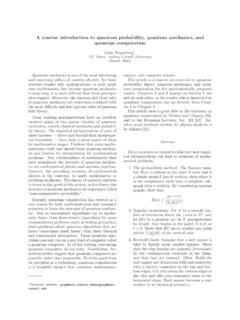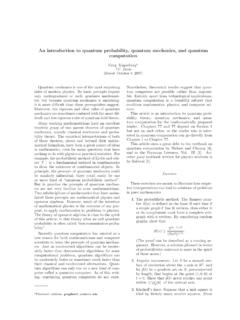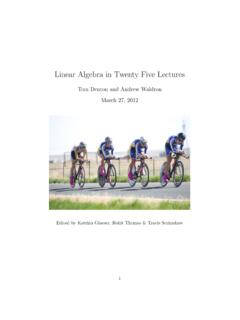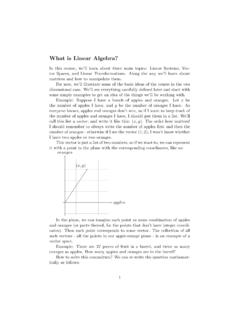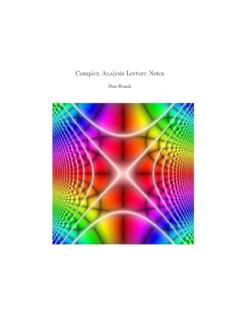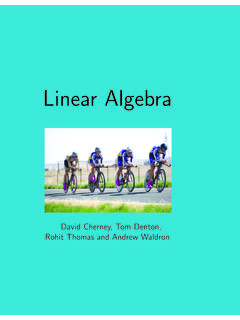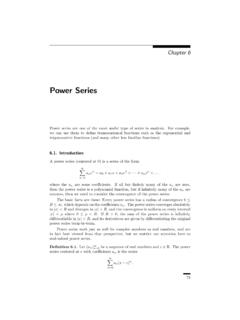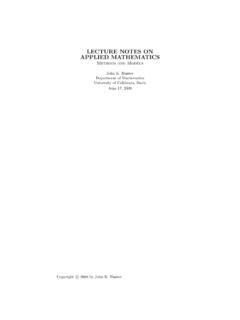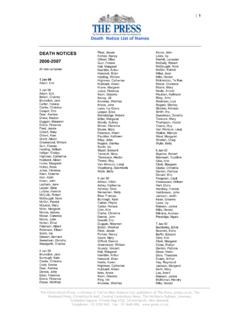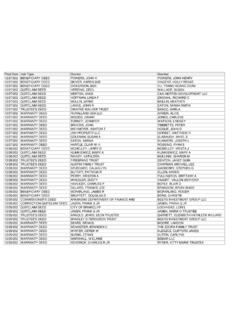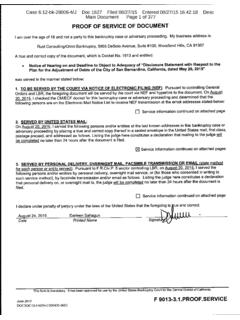Transcription of Twenty problems in probability - math.ucdavis.edu
1 1 Twenty problems in probabilityThis section is a selection of famous probability puzzles, job interview questions (most high-tech companies ask their applicants math questions) and math competition problems . Someproblems are easy, some are very hard, but each is interesting in some way. Almost all problemsI have heard from other people or found elsewhere. I am acknowledging the source, or a partialsource, in square brackets, but it is not necessarily the original should be reminded that all random choices (unless otherwise specified) are such thatall possibilities are equally likely, and different choiceswithin the same context are by defaultindependent.
2 Recall also that aneven beton the amountxon an event means a correct guesswins youx, while an incorrect guess means loss of the same [P. Winkler] One hundred people line up to board an airplane. Each has a boarding pass withassigned seat. However, the first person to board has lost hisboarding pass and takes a randomseat. After that, each person takes the assigned seat if it isunoccupied, and one of unoccupiedseats at random otherwise. What is the probability that the last person to board gets to sit inhis assigned seat?2. [D. Knuth] Mr. Smith works on the 13th floor of a 15 floor building. The only elevatormoves continuously through floors 1,2.
3 ,15,14, .. ,2,1,2, .., except that it stops on a flooron which the button has been pressed. Assume that time spent loading and unloading passengersis very small compared to the travelling Smith complains that at 5pm, when he wants to go home, the elevator almost alwaysgoes up when it stops on his floor. What is the explanation?Now assume that the building hasnelevators, which move independently. Compute theproportion of time the first elevator on Mr. Smith s floor moves [D. Barsky]NCAA basketball pool. There are 64 teams who play single elimination tourna-ment, hence 6 rounds, and you have to predict all the winners in all 63 games. Your score isthen computed as follows: 32 points for correctly predicting the final winner, 16 points for eachcorrect finalist, and so on, down to 1 point for every correctly predicted winner for the firstround.
4 (The maximum number of points you can get is thus 192.)Knowing nothing about anyteam, you flip fair coins to decide every one of your 63 bets. Compute the expected number [E. Berlekamp]Betting on the World Series. You are a broker; your job is to accommodateyour client s wishes without placing any of your personal capital at risk. Your client wishes toplace an even $1,000 bet on the outcome of the World Series, which is a baseball contest decidedin favor of whichever of two teams first wins 4 games. That is, the client deposits his $1,000with you in advance of the series. At the end of the series he must receive from you either $2,000if his team wins, or nothing if his team loses.
5 No market exists for bets on the entire world2series. However, you can place even bets, in any amount, on each game individually. What isyour strategy for placing bets on the individual games in order to achieve the cumulative resultdemanded by your client?5. FromNew York Times, Science Times, D5, April 10, 2001: Three players enter a room and a red or blue hat is placed on each person s color of each hat is determined by [an independent] coin toss. No communicationof any sort is allowed, except for an initial strategy session before the game they have had a chance to look at the other hats [but not their own], theplayers must simultaneously guess the color of their own hats or pass.
6 The puzzleis to find a group strategy that maximizes the probability that at least one personguesses correctly and no-one guesses incorrectly. The naive strategy would be for the group to agree that one person should guess and theothers pass. This would have probability 1/2 of success. Find a strategy with a greater chancefor success. (The solution is given in the article.)For a different problem, allow every one ofnpeople to place an even bet on the color of hishat. The bet can either be on red or on blue and the amount of each bet is arbitrary. The groupwins if their combined wins are strictly greater than their losses. Find, with proof, a strategywith maximal winning [L.]
7 Snell] Somebody chooses two nonnegative integersXandYand secretly writes them ontwo sheets of paper. The distrubution of (X, Y) is unknown to you, but you do know thatXandYare different with probability 1. You choose one of the sheetsat random, and observethe number on it. Call this random numberWand the other number, still unknown to you, task is to guess whetherWis bigger thanZor not. You have access to a random numbergenerator, , you can generate independent uniform (on [0,1]) random variables at will, soyour strategy could be a stategy for which the probability of being correctis 1/2 + , for some >0. This may depend on the distribution of (X, Y), but your strategy of course can A person s birthday occurs on a dayiwith probabilitypi, wherei= 1.
8 , n. (Of course,p1+ +pn= 1.) Assume independent assignment of birthdays among different people. Ina room withkpeople, letPk=Pk(p1, .. , pn) be the probability that no two persons share abirthday. Show that this probability is maximized when all birthdays are equally likely:pi= 1/nfor [Putnam Exam] Two real numbersXandYare chosen at random in the interval (0,1).Compute the probability that the closest integer toX/Yis even. Express the answer in theformr+s , whererandsare rational [L. Snell] Start withnstrings, which of course have 2nends. Then randomly pair the endsand tie together each pair. (Therefore you join each of thenrandomly chosen pairs.)
9 LetLbethe number of resulting loops. ComputeE(L).10. [Putnam Exam] AssumeCandDare chosen at random from{1, .. , n}. Letpnbe theprobability thatC+Dis a perfect square. Compute limn ( n pn). Express the result inthe form (a b+c)/d, wherea, b, c, dare [D. Griffeath] Let [0,1] be an arbitrary number, rational or irrational. The onlyrandomizing device is an unfair coin, with probabilityp (0,1) of heads. Design a gamebetween Alice and Bob so that Alice s winning probability isexactly . The game of course hasto end in a finite number of tosses with probability [Putnam Exam] Let (X1, .. , Xn) be a random vector from the set{(x1, .. , xn) : 0< x1< < xn<1}.
10 Also letfbe a continuous function on [0,1]. SetX0= 0. LetRbe the RiemannsumR=n 1 i=0f(Xi+1)(Xi+1 Xi).Show thatER= 10f(t)P(t)dt, whereP(t) is a polynomial of degreen, independent off, with0 P(t) 1 fort [0,1].13. [R. Stanley] You haven >1 numbers 0,1, .. , n 1 arranged on a circle. A random walkerstarts at 0 and at each step moves at random to one of its two nearest neighbors. For eachi,compute the probabilitypithat, when the walker is atifor the first time, all other points havebeen previously visited, , thatiis the last new point. For example,p0= [R. Stanley] ChooseX1, .. , Xnfrom [0,1]. Letpnbe the probability thatXi+Xi+1 1for alli= 1, .. , n 1. Prove that limn p1/nnexists and compute [Putnam Exam] Each of the triples (ri, si, ti),i= 1.

